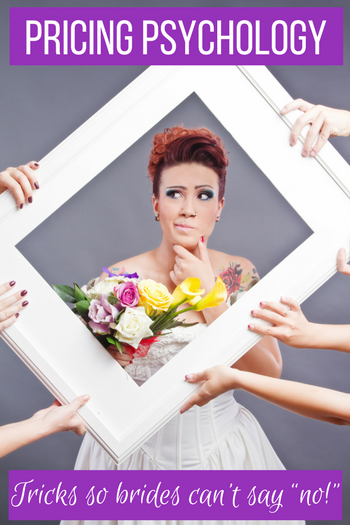Pricing psychology is not a new phenomenon. In fact, even if you look at the words “pricing psychology” or “strategic pricing,” you intuitively know what it means.

Overall, it’s a tactic that takes advantage of customers’ emotional responses to certain price points.
Since you’re in the wedding business, you’ve seen more than one emotional response, right? (Has a bride carried in your store today?)
Right. So this is nothing new.
If you think that strategic pricing is as simple as immediate pricing every item in your store $99.99 or anything else ending in $0.99, you’re partially right.
However, more techniques exist than just slapping a price tag that ends in $0.99 on everything in your store —and there are lots of marketing studies that prove it.
Charm pricing
Charm pricing is the technical name for the marketing magic that occurs when you, as a business owner, label things ending in $0.99. Or, ending in 9, for that matter. $99, for example. (There just might be magic in that number!)
For example, if you have a wedding planner and wedding priced at $4,999.99, customers see that figure interpret it as four thousand dollars, not five thousand dollars. Here’s a way to illustrate that:
Mom: “Honey, that’s an expensive dress. It’s $5,000.”
Bride: “Moooom, no, it’s only $4,999.”
To boot, customers really do favor odd pricing over whole number pricing.
Why?
It all comes down to rational thought—they perceive that your shop employed a rational “thought process” in the pricing of whatever they’d like to buy. Also, customers perceive odd pricing as your shop or business, having priced the item at the lowest possible price, maybe thinking, “Oh, they’re so nice. They saved me some money.”
Yep, sure did.
If they see whole numbers, they think they’re being overcharged. (They might believe a wedding dress at $5,000 is a rip-off, but if it’s $4,999.99—they believe the company worked super hard on their behalf to keep prices as low as possible.)
Prestige pricing strategy
Here’s another interesting phenomenon: prestige pricing strategy. This is a pricing strategy that sets the prices of luxury products to the expectations of a niche class of customers who associate higher prices with superior quality.
These customers are willing to pay higher prices because of the perceived social benefits they’ll automatically receive by owning the product.
Wedding businesses can—and should—totally capitalize on this higher-end strategy.
Only a limited number of individuals can afford certain wedding items, which adds to the wedding items’ exclusivity and appeals to these customers.
Those with expensive wedding products, take note.
Buy one, get one free
You’ll see this all the time with cereals, soaps, lotions, smaller products, etc. Maybe you even do this in your wedding shop with smaller items such as jewelry, garters, whatever!
People naturally gravitate toward the word “free.” We intuitively might know that there may be no difference in the actual final price between two items, but we would psychologically do anything for that “freebie.”
In fact, if you went around and did a street survey and asked whether someone would rather buy an item half off or buy one, get one free, it’s possible they’ll ask for free every time.
Comparative pricing
How does it work to highlight competitors’ higher pricing with your own? It might be risky, according to a study done and reported in the Stanford Graduate School of Business. Check it out.
And what about your competitors’ pricing? If your pricing is higher than your competitors’, you’re going to have to be able to convey the added value that comes at this price. Maybe you have better alteration options if you’re a wedding dress shop. Maybe you offer more personalized service. Maybe your customer service is spectacular.
Whatever it is, make sure they get that.
Visually highlight new prices
Or, there’s always the old stand-by: Cross out your old price and show the new price in bigger, bolder fonts. Font, size, color—it all works! Again, your customers will believer you’re doing them a huge favor in return and that you truly do care about their wallets.
And you do, right?
Also, it’s important to understand your customer, your competition, the market and your region. Pricing psychology campaigns will be completely different in Cheyenne, Wyoming compared to New York, New York.
Try some different pricing strategies (and do your research), and above all else, keep track of what works and what doesn’t. You might be pleasantly surprised!

